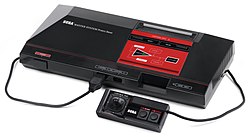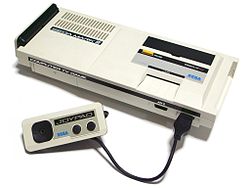Master System
The Sega Master System (SMS)[d] is a home video game console made in 1985. It was not very popular in North America and Japan but was very popular in Brazil. One of the most popular games of the Master System was Sonic the Hedgehog.
 | |
Top: North American/European Master System Middle: Japanese Sega Mark III Bottom: PAL Master System II | |
| Manufacturer | Sega |
|---|---|
| Type | Home video game console |
| Generation | Third generation |
| Release date | |
| Lifespan |
|
| Introductory price | JP¥16,800 US$200 GB£99 |
| Discontinued | |
| Units sold | Worldwide: 13 million (as of 2009) (not including recent Brazil figures)[5] Japan: 1 million (as of 1986)[6] United States: 2 million (as of 1993)[7] Europe: 6.8 million (estimated as of December 1993)[8] Brazil: 8 million (as of 2016)[9] |
| Media | ROM cartridge, Sega Card |
| CPU | Zilog Z80A @ 4 MHz |
| Memory | 8 kB RAM, 16 kB VRAM |
| Display | 256 × 192 resolution, 32 colors on-screen |
| Graphics | Yamaha YM2602B VDP |
| Sound | Yamaha VDP PSG(SN76489), Yamaha YM2413[a] |
| Backward compatibility | SG-1000[b] |
| Predecessor | SG-1000[c] |
| Successor | Sega Genesis |
| Related articles | Game Gear |
As of 2015[update], the Master System was still in production in Brazil by Tectoy. This would make it the world's longest-lived console.[10]
Background
changeLaunch
changeIn October 1985, the Sega Mark III was released in Japan for ¥15,000.[2]
The console was redesigned as the "Master System", and it was released in North America in 1986 at a price of $200 (equivalent to $494 in 2021). It included a multicart of the games Hang-On and Safari Hunt.[11] By the end of 1986, 125,000 Master System consoles had been sold. This was more than the Atari 7800's 100,000, but it was less than the NES's 1.1 million.[1]
The console was re-released as the Master System in Japan in October 1987 for ¥16,800.[4] It still sold poorly as did the Mark III.[12] Neither model posed a serious challenge to Nintendo in Japan.[6]
Transition to Genesis and decline
changeSega released the Mega Drive, a 16-bit video game console, in Japan on October 29, 1988.[13] The last game released for the Mark III/Master System in Japan was Bomber Raid in 1989.[12]
By early 1992, Master System production stopped in North America. By that time, between 1.5 million and 2 million units had been sold in the United States.[7][14]
The Master System later became a success in Europe. In Europe, it sold more than the NES by a lot.[8][15] As late as 1993, the Master System's active installed user base in Europe was 6.25 million units. That was larger than that of the Mega Drive's 5.73 million base that year.[8] Combined with the Mega Drive, Sega had the majority of the console user base in Europe that year.[15]
Continued success in Brazil
changeThe Master System has had the most success in Brazil. In Brazil, new versions have continued to be released. Tectoy has been manufacturing Master Systems since 1989. These versions include the Master System Compact[12] and the Master System 3.[16] In 2015, it was reported that the Master System sells around 150,000 units per year in Brazil.[17] By 2016, the Master System had sold 8 million units in Brazil.[9] Because Tectoy continued to produce the Master System years for so long, the Master System is considered the longest-lived in the history of video game consoles.[18]
Reception and legacy
changeIt is estimated that 13 million Master Systems were sold. This does not include recent Brazil sales.[5]
Notes
changeReferences
change- ↑ 1.0 1.1 Computer Entertainer, February 1987, page 13 Archived November 22, 2015, at the Wayback Machine
- ↑ 2.0 2.1 "Mark III" (in Japanese). Sega Corporation. Archived from the original on July 16, 2014. Retrieved March 31, 2014.
- ↑ 3.0 3.1 Gamers High! Futabasha Super Mook (in Japanese). Futabasha. 2015. p. 55. ISBN 978-4-575-45554-0.
- ↑ 4.0 4.1 "Master System" (in Japanese). Sega Corporation. Archived from the original on July 16, 2014. Retrieved March 31, 2014.
- ↑ 5.0 5.1 Buchanan, Levi (March 20, 2009). "Genesis vs. SNES: By the Numbers". IGN. Ziff Davis. Archived from the original on March 2, 2014. Retrieved March 31, 2014.
- ↑ 6.0 6.1 Nihon Kōgyō Shinbunsha (1986). "Amusement". Business Japan. 31 (7–12). Nihon Kogyo Shimbun: 89. Retrieved January 24, 2012.
- ↑ 7.0 7.1 Sheff, David (1993). Game Over (1st ed.). New York, New York: Random House. p. 349. ISBN 0-679-40469-4. Retrieved January 16, 2012.
- ↑ 8.0 8.1 8.2 "Sega Consoles: Active installed base estimates". Screen Digest. Screen Digest Ltd.: 60 March 1995.
- ↑ 9.0 9.1 Azevedo, Théo (May 12, 2016). "Console em produção há mais tempo, Master System já vendeu 8 mi no Brasil". Universo Online (in Portuguese). Grupo Folha. Archived from the original on May 14, 2016. Retrieved May 13, 2016.
Comercializado no Brasil desde setembro de 1989, o saudoso Master System já vendeu mais de 8 milhões de unidades no país, segundo a Tectoy.
- ↑ Fick, Matthew (January 17, 2014). "Longest-lived game consoles". IGN Africa. Ziff Davis. Archived from the original on November 6, 2015. Retrieved September 21, 2015.
- ↑ Beuscher, David. "Sega Master System – Overview". AllGame. All Media Network. Archived from the original on January 2, 2010. Retrieved March 31, 2014.
- ↑ 12.0 12.1 12.2 McFerran, Damien. "Retroinspection: Master System". Retro Gamer (44). London, UK: Imagine Publishing: 48–53. ISSN 1742-3155.
- ↑ Sczepaniak, John (2006). "Retroinspection: Mega Drive". Retro Gamer (27). London, UK: Imagine Publishing: 42–47. ISSN 1742-3155.
- ↑ "16-Bit Hits – New video games offer better graphics, action". Minneapolis Star Tribune – via NewsBank (subscription required) . October 15, 1991. Archived from the original on November 10, 2013. Retrieved April 7, 2014.
- ↑ 15.0 15.1 "Total 8-bit and 16-bit Cartridge Consoles: Active installed base estimates". Screen Digest. Screen Digest Ltd.: 61 March 1995. (cf. here [1] Archived March 24, 2017, at the Wayback Machine and here [2] Archived March 24, 2017, at the Wayback Machine)
- ↑ Szczepaniak, John (2006). "Company Profile: Tec Toy". Retro Gamer (30). London, UK: Imagine Publishing: 50–53. ISSN 1742-3155.
- ↑ Smith, Ernie (July 27, 2015). "Brazil Is An Alternate Video Game Universe Where Sega Beat Nintendo". Atlas Obscura. Archived from the original on June 21, 2017. Retrieved December 11, 2017.
- ↑ Fick, Matthew (17 January 2014). "The 5 longest console lifespans". IGN Africa. Ziff Davis. Archived from the original on November 6, 2015. Retrieved November 30, 2015.


